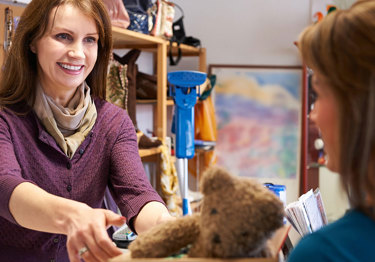 Access Charity CRM
Access Charity CRM
Ultimate guide to successful donor relationships
Trust is pretty important in any relationship. And for charities and their donors, it’s paramount. Yet, nearly half (45%) of people claim their trust in charities has fallen in the past year, while just four per cent say it’s increased. Clearly there is some work to be done to become a trusted charity in the eyes of donors.
It’s no longer enough for charities to simply inspire people with what they do. Donors want to feel listened to and understood. They want to know that you care what they think. Every interaction needs to be thoughtful and considered to build a strong relationship with your donors. A good experience they’d want to repeat will help to engage and retain your donors too. You need to take them on a carefully planned, yet flexible journey that’s right for them.
There are four key ways to help you develop strife-free and fruitful donor relationships that last.

What's covered in this guide:
- Segmentation: understanding why different donors give to charity
- Cultivating donors through personalisation: talk to people not demographics
- Integration as part of your donor management process: join up, stand out
- Donor data: make it work for you
1. Segmentation: understanding why different donors give to charity
Segmentation is about getting under the skin of different groups of donors and potential donors. Who are they? What makes them tick? How do they interact with your charity? That knowledge will allow you to divide your audiences into different groups and target each of them in the most effective way.
Why bother?
When it comes to fundraising, one size will never fit all. Your donors are all individuals with different backgrounds, experiences and reasons for donating their hard-earned cash. If you’re going to make people feel valued and inspire them to keep supporting your cause, you need to consider everything about them: from who and where they are, to what they’ve done and why they’ve done it. Thanks to technology and data, plus a little creativity, you can gather this information for your fundraising campaign and use it to tailor the products and opportunities you offer.
How can you do it?
Here’s a whistle-stop tour of the different ways you can segment your fundraising audience:
Segmentation conclusion
Unsurprisingly, a combination of segmentation methods is usually the most effective to engage donors and increase donation levels.
Wherever possible, look at attitudes and behaviours together, using context or geo-demographic data too. This will give you the most detailed picture of your donors and potential donors allowing you to group them appropriately for your fundraising campaigns.
2. Cultivating donors through personalisation
Personalisation is a whole lot more than using someone’s name on your email. To build the best relationships with your donors, and attract new ones, you need to be able to offer them what they want in the way they want it. This involves customising content and tailoring communications to make each group of donors feel valued and understood.
Why bother?
You’ve spent time and money getting to know your audience and segmenting the donors according to what you’ve learned. So it would be a waste to send them all the same messages in the same way. Tailoring communications increases donor engagement and boosts conversion. Personalised supporter journeys are vital to a successful donor relations strategy if you’re going to acquire new donors, and retain the ones you already have.
Expert tips: How to re-engage lapsed donors
- It can cost up to 10 times as much to recruit a new donor as to retain an existing one. So it’s worth making time for winning back lost friends.
- Find out why your donors stopped donating: It seems obvious, but have you been in touch to ask? Phone calls and focus groups are ideal and even short online surveys will help you build a picture of what’s been happening.
- Have open conversations: Find out what your donors really think. Listen to their concerns and ask for suggestions.
- Test some new fundraising techniques and approaches: Raffles and prize-led fundraising can be an interesting option to consider with lapsed supporters.
- Reiterate your impact in a ‘win them back’ communication: Don’t forget your segments. Keep supporters’ different needs and preferences in mind when you’re approaching reactivation.

3. Integrated fundraising campaigns to increase charitable giving
Everyone in your charity should have the same ultimate goal: making a difference to your cause. Integration is about aligning your fundraising strategies and messages, as well as your systems and processes, to help you achieve this.
Why bother?
Fundraising rarely happens in isolation. It’s inextricably linked to other functions in your organisation. Yet charities can be guilty of working in silos. Remember, people don’t identify with the boxes you put them in. Ever heard someone say, “Oh yes, I’m a warm DM recipient at Charity X”? When you think about your donor audiences, someone who takes part in a fundraising collection one day could call your helpline another. A regular charitable giver might also sign your campaigning petition or run 5k to fundraise for you.
That’s why your planning, thinking and communications need to be joined up and consistent. Integration helps you to avoid over-contacting supporters or sending out conflicting messages. As well as having more impact, an integrated fundraising campaign will save resources, avoid duplicating work and help build your brand.
How can you do it?
4. Donor data: make it work for you
Good decisions depend on good information. Collect and interpret data wisely and it’ll help you find new donors and keep existing ones happy and active. Without data, you couldn’t do any of the things we’ve talked about so far. Successful donor segmentation, personalisation and integration all rely on strong, clean data.
Why bother?
The right data will tell you what works and what doesn’t. It’ll help you target the right donors at the right time in the right way. And you can use it to set ambitious but achievable goals. When you have a gut instinct, you can test it by turning to data. Did a segment of supporters respond to a message as you expected? You can use data to strengthen a business case, for example for investing in a new event or extending a fundraising campaign. You don’t need the skills of a technical database manager either. Run straightforward records from your CRM as evidence.
How can you do it?
Make sure you’re complying with privacy rules when you’re asking for supporter information.
Expert Tips: Major donor cultivation
- When you’re looking to approach new major donors, delve into your data to find your best prospects.
- Know everything you can about them and what makes them tick.
- Prepare a personalised case for support, using what you know about your donor when approaching them for funding.
- Be ready to share your impact stats. What difference could this donor make to your work.
- Expect them to do their own research – always be honest and transparent.
- Prepare for them to get involved and meet people.
- Know who else in your organisation is talking to them so you don’t double up or over contact.
- Stay in touch. Don’t disappear once you’ve received a donation. Schedule follow ups in your CRM aimed to engage and retain.

Download the full guide
Download the full Successful Donor Relations guide including our Donor Engagement checklist

 AU & NZ
AU & NZ
 SG
SG
 MY
MY
 US
US
 IE
IE


















